6 - Lymphatics of the Lungs
Editors: Shields, Thomas W.; LoCicero, Joseph; Ponn, Ronald B.; Rusch, Valerie W.
Title: General Thoracic Surgery, 6th Edition
Copyright 2005 Lippincott Williams & Wilkins
> Table of Contents > Volume I - The Lung, Pleura, Diaphragm, and Chest Wall > Section II - Physiology of the Lungs > Chapter 8 - Mechanics of Breathing
Chapter 8
Mechanics of Breathing
Carl R. O'Donnell
The term mechanics of breathing refers to the elastic properties of the lung and chest wall and to airflow resistance. These properties are described by and related to lung volume and airflow measurements, the standard tests of ventilatory function (Table 8-1). The standard subdivisions of the lung volume are shown in Fig. 8-1.
ELASTIC PROPERTIES OF THE LUNG AND CHEST WALL
The lung is a volume-elastic container that tends to deflate itself. The deflation force exerted by the lung is termed elastic recoil pressure. This pressure increases with lung volume, and the pressure required to maintain inflation equals the elastic recoil. Lung expansion is maintained either by negative pleural pressure at the outer surface of the lung or by positive pressure applied via the airway opening to the inner surface of the lung. Irrespective of the manner in which inflation pressure is applied, lung recoil pressure is considered positive and is always expiratory. Lung recoil pressure is expressed as the pressure difference between the alveolar lumen and the pleural space: Alveolar pressure (Pa)pleural pressure (Ppl) = transpulmonary pressure (Ptp). Alveolar pressure is equivalent to atmospheric pressure in the absence of airflow, when the glottis and mouth are open. Therefore, under these conditions, intrapleural pressure is equal but opposite in sign to elastic recoil pressure.
The pressure difference between the alveolar lumen and the outer surface of the chest wall (body surface) is termed transthoracic pressure. Transthoracic pressure is the sum of pressures derived from lung and chest wall elastic recoil and active inspiratory or expiratory effort. Thus, pressure across the respiratory system (Prs) is the sum of pressure from lung elastic recoil (Pl) and pressure from both chest wall recoil and ventilatory effort (collectively, Pcw): Prs = Pl + Pcw.
The elastic properties of the lung reside both in the elastic continuum that bounds and mechanically couples alveolar walls and in the liquid lining of individual alveoli. The lung parenchyma contains a continuous elastic network of collagen, elastic, and reticular fibers in addition to alveolar capillary endothelium and the alveolar epithelial lining. In addition, a thin liquid film on the luminal surface of the alveolar epithelium creates a surface tension that accounts for a substantial portion of lung recoil. Surface tension tends to minimize surface area. In the bubblelike alveolus, surface tension increases as the size of the alveolus decreases, and, if unopposed, leads to alveolar instability because smaller units, with greater recoil, tend to empty into larger units. A lipid substance normally present in the alveolar lining fluid reduces surface tension at the gas liquid interface, thereby protecting the lungs against alveolar collapse. This substance, surfactant, can be extracted from normal lung tissue and is absent or reduced in acute lung injury, prolonged pulmonary atelectasis, and hyaline membrane disease. Surfactant maintains relatively constant surface-tension forces despite varying degrees of lung inflation and alveolar size.
Under static conditions (i.e., in the absence of airflow), a given degree of lung inflation is maintained either by active inspiratory muscle contraction, passive inspiratory elastic recoil of the chest wall, or some combination of both. The resting end-expiratory lung volume or relaxation volume is the result of the balance between equal but opposite forces generated by the inward elastic recoil of the lungs and the outward recoil of the chest cage. At rest, relaxation volume corresponds closely to the functional residual capacity (FRC).
Pleural pressure changes can be accurately measured in the upright posture by placing a small tube with an attached balloon in the esophagus. A plot of lung volume versus pleural pressure, made under static conditions (Fig. 8-2), describes the elastic properties of the lung. In practice, multiple separate static measurements of intrapleural pressure and corresponding lung volume over the entire range of lung deflation are used to describe the pressure-volume characteristic of the lung. This pressure-volume (PV) relationship is termed lung compliance. Over the resting tidal volume range, the PV relationship is ordinarily linear, with slope expressed as change in volume per unit change in pressure (milliliter per centimeter H2O).
Table 8-1. Subdivisions of Lung Volume | |
|---|---|
|
P.105
Lung inflation and deflation are accomplished by changes in the dimensions of the chest wall. These dimensional changes are determined in part by the elastic properties of the bony and soft tissue structures of the thorax and by the muscle forces that impart motion to the respiratory system. Like the lung, the chest wall exerts a passive recoil pressure proportional to its volume of expansion. This pressure is measured as the difference between pleural pressure and body surface pressure under static conditions when the muscles of respiration are relaxed. By plotting this pressure against the thoracic gas volume, one obtains the pressure-volume characteristic of the chest wall. Over much of the thoracic volume range, chest wall recoil is inspiratory. Since the lungs and chest wall are mechanically coupled by the pleural fluid, inspiratory chest wall recoil opposes the expiratory recoil of the lung. The compliance of the chest wall, as described by the slope of this relationship, is normally high enough so that the rib cage and soft tissue structures do not restrict respiratory movement. In the healthy ventilatory system, the lungs and chest wall contribute approximately equal portions of the total compliance over the normal tidal volume range. In the average adult, lung and chest wall compliance are each approximately 200 mL per cm H2O. Total respiratory system compliance (Crs) is calculated by adding the reciprocal compliance of each component (lung and chest wall) and then taking the reciprocal of the sum: 1/Cl + 1/Ccw = 1/Crs, or 1/200 + 1/200 = 1/100; normal Crs is therefore approximately 100 mL/cm H2O.
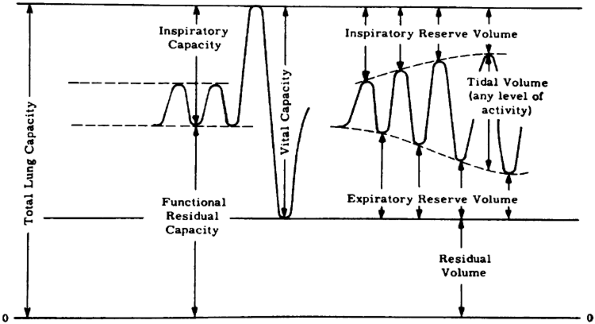 |
Fig. 8-1. Lung volumes. From Standardization of definitions and symbols in respiratory physiology. Fed Proc 9:602, 1950. With permission. |
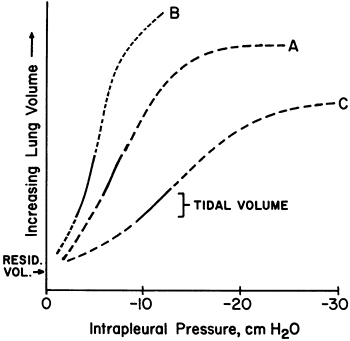 |
Fig. 8-2. Pressure-volume curves. A. Normal. B. Emphysema. C. Pulmonary fibrosis. The solid line represents the tidal volume in these three conditions. Resid. Vol., residual volume. |
The pressure-volume relationship is basic to an understanding of the fundamental relation between the work of breathing and lung mechanics. The stiffer lung displays a more horizontal curve (Fig. 8-2C), meaning that it takes a greater pressure to achieve the same inflation volume compared with a normal lung (Fig. 8-2A). These lungs are called less compliant. At lung volumes approaching total lung capacity (TLC), considerably more pressure per liter of inspired volume is required than at smaller lung volumes. In both health and disease, the tidal volume tends to occurs on the steepest part of the pressure-volume curve, where the largest volume change is accomplished with a minimal pressure change. For a given ventilatory requirement, there is an optimal pattern of tidal volume and breathing frequency at which the work of breathing is minimal. Normally, the work of breathing accounts for a very small fraction of total energy expenditure (<2% at rest) and does not limit ventilation even in the face of increased metabolic demand such as occurs during exercise.
P.106
When the lungs are noncompliant, as in pulmonary fibrosis, a pattern of rapid shallow breathing is adopted, which minimizes the work of breathing by decreasing the distention of abnormally stiff lung tissue during each breath. Even so, more effort than normal is required to sustain a given ventilation (see Fig. 8-2C). Although it might appear that the patient with highly compliant emphysematous lungs may have the advantage that less effort is required to deform the lung tissue (Fig. 8-2B), the work of breathing is increased because expiratory airflow obstruction causes hyperinflation, in which tidal breathing is shifted to a less advantageous position on the pressure-volume curves of lung and chest wall.
In addition, hyperinflation places the inspiratory muscles, particularly the diaphragm, in mechanically disadvantaged positions in which they are less able to generate force. This occurs both as a result of submaximal overlap of contractile proteins and flattening of the diaphragm. A significant portion of the diaphragm's pressure-generating capacity derives from the curvature of hemidiaphragmatic domes.
Lung volume reduction surgery, advocated for patients with severe emphysema, entails the surgical removal of the portions of the lung that function least well, thereby reducing intrathoracic volume. This may theoretically provide benefit by reducing elastic load, increasing lung elastic recoil pressure, and restoring the respiratory muscles to a more advantageous mechanical position.
Although pressure changes in the lung are similar everywhere during inflation, ventilation is not evenly distributed throughout the normal organ. At successive horizontal levels of the lung, from apex to base, the volume change produced by a given pressure change becomes progressively greater. The most dependent portions of the lung receive more ventilation per unit of lung tissue than the uppermost levels. The reason for this discrepancy is the effect of gravity. Although pressure changes producing inflation are essentially the same over the normal lung surface, the absolute pressure is not. In the upright position, the weight of the lung makes the intrapleural pressure at the lung base less negative than it is at the apex. With a less negative intrapleural pressure at the bases, the elastic recoil pressure and the volume of each alveolus at the base are less than in higher regions at the onset of inhalation (Fig. 8-3). With inflation, the pressure change transmitted to all lung tissue is the same, but different regions inflate to different volumes depending on where along the pressure-volume curve inflation commences. A dependent portion has a lesser recoil pressure to begin with; therefore, to the extent that inflation of basal alveoli occurs over a steeper portion of the pressure-volume curve, a normal breath inflates basal more than apical regions. Perfusion of the normal lung is similarly affected by gravity, so that a fairly good match between ventilation and perfusion is maintained throughout the lung.
In diseases of the lungs in which the elastic properties are not uniformly the same, regional ventilation becomes nonuniform. Adjacent lung regions, even neighboring alveoli, have different pressure-volume characteristics. Thus, the same pressure change, even when beginning at the same absolute level of intrapleural pressure, produces different volume changes in neighboring areas. The pressure-volume characteristics as measured with an esophageal balloon are those of the whole lung and are averages that may obscure regional differences. Diffuse infiltrative disease, such as diffuse pulmonary fibrosis, produces inequalities not only in inspired gas distribution, but also in the distribution of blood flow, resulting in ventilation-perfusion mismatch and abnormal gas exchange. The overall adverse effects of these diseases can often best be assessed by measurements of gas exchange and arterial blood gas content (see Chapter 7).
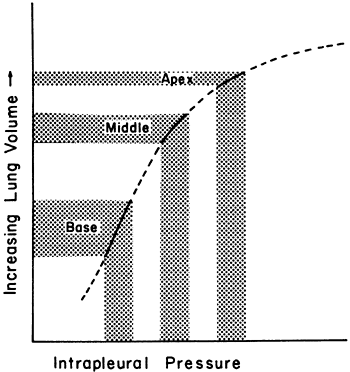 |
Fig. 8-3. Effect of gravity in the upright position. As one approaches the base of the lung, there is a greater volume change per unit of lung tissue for the same pressure change. |
Aside from processes that alter lung elastic recoil, there are others that restrict movement of the chest wall, reducing its compliance. An increase in the longitudinal dimension of the thorax is primarily determined by movement of the diaphragm. Diaphragmatic movement may be restricted by conditions that increase intraabdominal pressure, such as obesity, ascites, intraabdominal tumors, and inflammation of abdominal structures. Changing from the erect to the supine position also may restrict the diaphragm by shifting the weight of the abdominal contents toward the diaphragm. These conditions generally increase the inspiratory work of breathing and reduce FRC. In the extreme, vital capacity and TLC are also reduced.
Changes in the anteroposterior and transverse dimensions of the chest wall are primarily affected by the intercostal muscles and accessory muscles of respiration, and depend on the mobility of the rib cage. Thus, conditions that result in deformation or fixation of the thorax, such as kyphoscoliosis or ankylosing spondylitis, also may restrict expansion.
P.107
Obesity also may reduce chest wall compliance by increasing the soft tissue mass of the thorax. Moreover, because respiratory movement ultimately depends on the action of the respiratory muscles, conditions that result in paralysis or weakness of the respiratory muscles severely limit ventilation and often cause respiratory failure. Because of the difficulties of measuring chest wall compliance, muscle strength, and leverage, as well as intraabdominal pressure and gravitational forces, it is customary to rely on measurements of their consequences, such as changes in lung volumes, gas exchange, ventilation, and perfusion. The results of these tests plus knowledge of the clinical status of the patient are often sufficient to differentiate altered compliance of the chest wall or lungs from neuromuscular insufficiency.
AIRFLOW RESISTANCE
To generate airflow, ventilatory muscles must not only distend elastic structures of the lungs and chest wall, but must also develop the force to overcome frictional resistance to motion. Frictional resistance consists of pressure losses both from airflow through conducting airways and tissue flow within the lung and chest wall during breathing movements. Unlike measurements of elastic recoil pressure made under static conditions, resistance is a dynamic property and must be measured while there is airflow. The components of total airflow resistance within the lungs and thorax are airway resistance, lung tissue resistance, and chest wall tissue resistance. Change in tissue resistance tends to be minimal in most obstructive lung disease and is therefore overshadowed by the magnitude of change in airway resistance. The majority of expiratory airflow resistance ordinarily occurs in larger, more central airways, those 2 mm or more in diameter.
Direct measurement of airway resistance is technically difficult and yields variable results. Therefore, indirect measurements, such as the peak expiratory flow or the volume exhaled during the first second of the forced vital capacity maneuver (FEV1), are commonly used to assess airway resistance. These measurements are made during maximally forced expiratory efforts.
These indirect measures of airflow resistance provide average values for the entire system of airways. In diffuse obstructive lung diseases, such as chronic obstructive pulmonary disease (COPD) and asthma, some airways have a higher resistance to airflow than others, resulting in nonuniform distribution of inspired air and a mismatch between ventilation and perfusion with impairment of gas exchange.
Airway Resistance During Exhalation
Maximum expiratory flow is primarily determined by mechanical properties of the lungs and airways and is usually not limited by effort. At most lung volumes, maximum expiratory flow can be achieved with submaximal expiratory effort. This concept is illustrated in the isovolume pressure-flow curves in Fig. 8-4. These curves are obtained by performing a series of active exhalations with increasing effort at a particular lung volume and plotting the resulting flow rates against corresponding pleural pressures. In this instance, pleural pressure represents the driving pressure or force related to muscular effort. In Fig. 8-4, curves obtained at three different lung volumes are represented. Between TLC and 75% of TLC, flow increases with effort and depends not only on pleural pressure but also on the patency of airways and the elastic recoil of the lung at high volumes. At volumes below approximately 75% of TLC, expiratory flow increases with effort up to a point beyond which further increases in effort do not lead to a higher flow rate. Flow limitation occurs as expiratory resistance within the intrathoracic airways decreases gas pressure by an amount equal to elastic recoil. The point along the airway at which this occurs, the equal pressure point (EPP), sees gas pressure within the intrathoracic airway equivalent to the pleural pressure on the outer surface of the airway. With further resistive pressure loss in the downstream (mouthward) airway segment, pressure across the airway wall (transmural pressure, or Ptm) becomes negative and the airway tends to be compressed. Flow reaches a maximal level at this point because further increases in pleural pressure resulting from effort tend to compress airways and limit flow to the same extent that they tend to drive flow. This dynamic compression occurs because intrathoracic airways are exposed to pleural pressures.
This concept is illustrated by the model in Fig. 8-5. In this model, the lung or alveolus and airway are suspended in a box representing the thorax. The lung is separated from the chest wall for descriptive purposes only, and the space between the lung and chest wall should be considered the airless pleural space. The numbers represent pressure in centimeters of water. In Fig. 8-5A, the pleural pressure is
P.108
equal to the pressure surrounding the airways. At this level of lung inflation, the pleural pressure is equal and opposite in sign to the elastic recoil pressure of the lung (+10; no pressure gradient is present to produce airflow), and net alveolar pressure is atmospheric, or zero. During active exhalation (Fig. 8-5B), pleural pressure becomes positive, to +10. Because alveolar pressure is equal to the sum of pleural pressure and lung recoil pressure, it increases by an amount equal to the increase in pleural pressure. At this point, the difference between alveolar pressure (+20) and airway opening pressure (0) represents the total pressure producing expiratory flow. It follows that as pressure falls due to flow resistance, at some point between the alveolus and airway opening the airway intraluminal pressure is equal to pleural pressure, and intraluminal pressures downstream from this point are less than pleural pressure. If this occurs along intrathoracic airway segments, where pressure surrounding airways is pleural, downstream segments tend to collapse, limiting flow. With any further increase in effort, the downstream segment tends to collapse even further. In this case, any additional increase in driving pressure resulting from greater effort is merely dissipated in keeping the collapsed segment open.
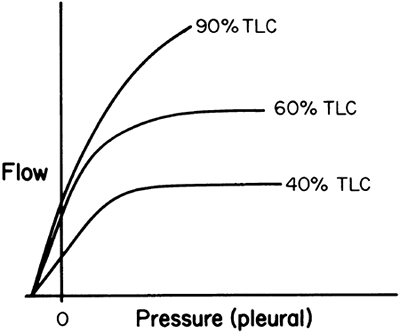 |
Fig. 8-4. Isovolume pressure flow plot at three different lung volumes. TLC, total lung capacity. |
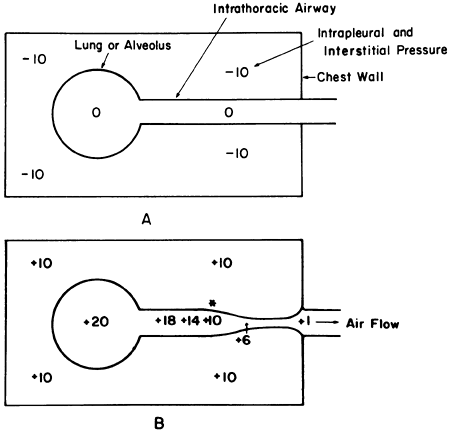 |
Fig. 8-5. Model illustrating pleural pressures. Static recoil pressure is +10 cm H2O. A. Static conditions. B. Dynamic conditions. Airway is compressed downstream from the point marked by the asterisk. |
Because this dynamic expiratory collapse occurs with submaximal effort over most of the vital capacity, maximum expiratory flow is not limited by effort during the forced vital capacity (FVC) maneuver. Instead, maximum flow is determined by intrinsic characteristics of the lung such as lung recoil pressure and the resistance of peripheral airways upstream from the EPP. Therefore, diseases such as emphysema that reduce the elasticity of airways and lung tissue tend to produce flow limitation by reducing the driving pressure and by making airways more collapsible. Diseases such as chronic bronchitis and asthma produce flow limitation by increasing the resistance of upstream or peripheral airways. Because maximal expiratory flow over the effort-independent range of the vital capacity (below 75% of TLC) depends on the resistive characteristics of intrathoracic airways, tests of forced exhalation have become a useful means of detecting, quantifying, and following obstructive lung disease.
Because of the pressure, volume, and flow relations of the lung, the presence of airway obstruction can be determined by measuring maximal expiratory flow. Because maximal flow is relatively independent of effort and primarily dependent on the recoil pressure of the lung, and because the recoil pressure of the lung is dependent on lung volume, one need only relate the measured flow to the lung volume at which it is measured; this relation is called a flow-volume curve (Fig. 8-6).
Expiratory flow limitation ordinarily occurs within more central airways at higher lung volumes and within smaller, more peripheral airways at lower lung volumes. Because chronic airflow obstruction is thought to progress from smaller, more peripheral airways to larger airways, much attention has been focused on identification of reduced maximum expiratory flow at lower lung volumes in the early detection of COPD. It has been proposed that by measuring forced expiratory flow at a low lung volume, say when 50% or 75% of the vital capacity has been exhaled, and comparing it with established normal standards, one
P.109
might detect the presence of minimal airflow limitation. Thus, measurements made from the end-expiratory portion of the maximal expiratory flow-volume curve could identify patients with early expiratory airflow limitation before abnormalities occur in their timed vital capacity measurements. In practice, while such measurements may be more sensitive, they are neither as reproducible nor as specific as spirometric tests of forced exhalation that relate expired volume to the time of exhalation, such as the FEV1.
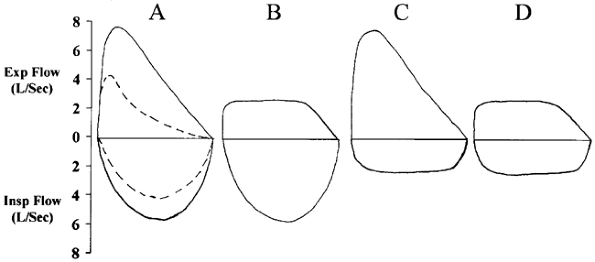 |
Fig. 8-6. Schematic representation of normal and abnormal flow volume loops. Flow is on the ordinate and volume on the abscissa, with residual volume to the right and total lung capacity to the left. A. The solid line represents a normal flow volume loop. The dashed line represents a typical loop from a patient with obstructive airway disease, in which the greatest reduction in airflow occurs in the mid and low ranges of the vital capacity. B. Flow volume loop shows a truncated expiratory (Exp) limb with normal inhalation, indicative of a variable intrathoracic obstruction such as an eccentric endotracheal tumor. C. The truncated inspiratory (Insp) limb with a normal-appearing expiratory limb is consistent with a variable extrathoracic upper airway obstruction (e.g., laryngeal lesions, vocal cord paralysis). D. Reduced maximal flows during both inhalation and exhalation are characteristic of a fixed upper airway obstruction, usually seen with circumferential airway lesions. |
Airway Resistance During Inhalation
Airway cross section varies depending on both transmural pressure and airway compliance. Transmural pressure depends on flow direction and airway location. For intrathoracic airways, transmural pressure is negative (compressing) during exhalation and positive (distending) during inhalation. The tendency of intrathoracic airways to collapse during forced exhalation results in flow limitation as described previously. The transmural pressure across extrathoracic airways is in the opposite direction negative during inhalation and positive during exhalation.
Inspiratory airflow is effort limited and thus increases in direct proportion to the force or effort applied. Patients with chronic obstructive pulmonary disease, in whom impaired expiratory airflow is invariably present, may have decreased inspiratory flow as well. Inspiratory flow may be reduced in patients with chronic bronchitis and in those with asthma because the bronchial lumen is narrowed by secretions, exudate, and bronchospasm. Inspiratory flow is reduced also when airways become stiff and less expansile because of inflamed bronchial walls or become narrow owing to decreased radial traction (Fig. 8-7). However, the magnitude of reduced inspiratory flow does not provide a reliable index of the presence or severity of chronic airflow obstruction in emphysema, asthma, and most other airway diseases. Inspiratory flow measurements, usually made from an inspiratory flow-volume loop (see Fig. 8-6), are primarily useful in unusual, but often remedial, localized obstructions of major airways that may occur in the setting of glottic or immediately subglottic lesions, vocal chord dysfunction, and the like. Dynamic extrathoracic obstructions primarily limit inspiratory flow, whereas fixed orifice obstructions limit both inspiratory and expiratory flow.
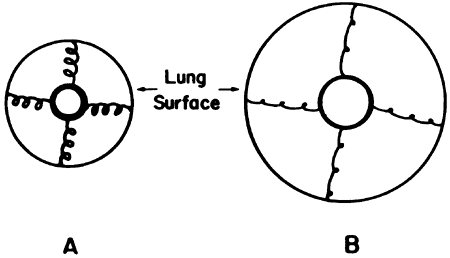 |
Fig. 8-7. Effect of inhalation on an intrapulmonary airway. A. End exhalation. B. End inhalation. The inner circle also could represent an alveolus. |
CLINICAL APPLICATION OF LUNG MECHANICS
Forced Vital Capacity
The forced vital capacity is perhaps the most frequently used objective clinical tool to assess mechanical characteristics of the ventilatory system. The maneuver is well standardized, reproducible, and relatively simple to perform. Reference values are well characterized, and there are widely accepted guidelines for interpretation of results. Analyses from the FVC include the total volume expired and the forced expiratory volume in 1 second (FEV1). Both the total FVC and the FEV1 may be reduced as a consequence of either a restrictive or obstructive process. On the other hand, the FEV1/FVC ratio, or the fraction of the FVC exhaled in 1 second, is reduced by obstruction, but not by restriction in the absence of a concurrent obstruction. For this reason the FEV1/FVC ratio is recommended as the most reliable indicator of an obstructive ventilatory defect.
Another index of airflow is the forced expiratory flow between 25% and 75% of vital capacity (FEF25% 75%). Although the FEF25% 75% has been proposed as a measure of small airway function, it is highly variable in the normal population and exquisitely sensitive to the lung volume at which it is measured. At this time, FEF25% 75% is therefore not considered a reliable indicator of early stage or minimal COPD.
Peak Flow
Peak flow can be measured either from the flow-volume loop (see Fig. 8-6) or with a simple handheld anemometer-type device such as the Wright peak flow meter. These two methods may not give comparable results, and both are somewhat variable depending on patient effort. Despite these limitations, determination of peak flow is one test that young children are often able to perform well and is therefore often the best available test of airflow obstruction in pediatric practice. In general, measurement of peak expiratory flow rate with a portable device is a simple but objective means to monitor the severity of airway obstruction, particularly among asthmatic patients. Subjects typically measure peak expiratory flow rate once or twice daily and compare these values with their personal best peak expiratory flow rate. Coupled with changes in symptoms, values less than 80% of an individual's best value may indicate an exacerbation and the need for more aggressive therapy or medical evaluation.
P.110
Maximum Voluntary Ventilation
Maximum voluntary ventilation (MVV) is determined by having the patient perform rapid deep breathing for a fraction of a minute. The expired volume is measured over several breaths, and the ventilation is expressed in liters per minute. In addition to ventilatory mechanics, the determination depends on neuromuscular function and patient cooperation. When properly performed, it provides an index of overall capacity that may be useful for predicting maximum ventilation during exercise. The degree of cooperation required for proper performance of MVV contributes to an excessive intertest variability that detracts from its reliability as a diagnostic or monitoring test.
LUNG VOLUME MEASUREMENTS
An isolated modest decrease in lung volume does not limit performance as long as adequate volume remains to permit normal alveolar ventilation. Although the tidal volume normally increases with exercise, the ventilation necessary for a given level of exercise can be achieved by increasing either tidal volume or breathing frequency. Thus, compensation for a limited lung volume can be attained by increasing the breathing frequency. In the presence of lung diseases characterized by airway obstruction, however, ventilation is maintained by a relatively greater increase in tidal volume than in frequency. This interrelation between tidal volume and frequency is further considered in the section The Work of Breathing, later in this chapter.
The reduction of lung volume occurring with diseases of the chest wall, lungs, or pleura provides a crude guide to the severity of the disease. Thus, volume measurements may be useful for deciding when therapeutic intervention is appropriate or assessing therapeutic efficacy. Lung volume measurements are made easily, and their reproducibility renders them useful for serial evaluation of patients. Although no specific diagnosis is suggested by a lung volume decrease, simple volume measurements, particularly the vital capacity, are just as sensitive an index of disease as the direct measurement of mechanical factors that determine static lung volumes, such as lung compliance.
Vital Capacity
The vital capacity is usually determined by measuring either slow or maximally rapid exhalation from total lung capacity to residual volume (see Fig. 8-1). Vital capacity is typically reduced in restrictive ventilatory defects. However, reduced vital capacity is not specific for a restrictive process and may reflect gas trapping secondary to airflow obstruction.
Functional Residual Capacity
The FRC is the volume of gas remaining in the lungs at the end of normal exhalation. As described earlier, during quiet breathing at rest the FRC corresponds closely to lung relaxation volume. However, end-expiratory lung volume normally varies according to posture, ventilatory drive or demand, and use of the ventilatory apparatus for nonrespiratory functions such as phonation. By convention, FRC is measured during quiet tidal breathing at rest in the sitting position. Techniques for determining FRC deserve some attention here because this measure provides the basis for estimating most other lung volumes. Two methods are commonly used for measurements of FRC. One employs inert gas dilution or resident gas washout, whereas the other, body plethysmography, measures simultaneous pressure-volume changes in intrathoracic and plethysmographic gas as a subject breathes within an enclosed chamber.
Helium is the inert gas commonly used for the dilution technique, whereas nitrogen is displaced by breathing 100% oxygen for the washout method. For an accurate determination, the gas must be evenly distributed or washed out from all air-containing units of the lung. This may not occur or may occur only slowly in the presence of bullous disease, airway obstruction, or other conditions in which portions of the lung are poorly ventilated.
For the plethysmographic method of measuring FRC, the subject sits in an airtight cabinet, the body plethysmograph. Measurements of changes in alveolar pressure and lung volume are made simultaneously while the patient is panting against an obstruction to airflow that is interposed briefly at the mouth. Alveolar pressure is equivalent to the pressure at the mouth under these circumstances. Theoretically, all of the gas within the chest, even in the presence of airway obstruction or bullous disease, is measured. This is true to the extent that pressure change everywhere in the lung and airways is uniform and simultaneous. In practice, these conditions cannot be assumed without very careful control of test technique. Therefore, although a discrepancy between plethysmographic and inert gas volume determination may reflect the volume of poorly ventilated lung, it may also reflect a tendency toward plethysmographic overestimation of volume in the setting of airflow obstruction.
The FRC tends to be reduced in the setting of reduced chest wall or lung compliance. In neuromuscular disease, the FRC may be relatively unchanged compared with lung volumes requiring active inhalation or exhalation, such as the vital capacity. FRC is often elevated in obstructive lung disease, reflecting gas trapping.
Residual Volume
The residual volume, air remaining in the lungs after complete exhalation, is typically calculated by subtracting
P.111
the expiratory reserve volume (ERV, see Fig. 8-1) from the FRC. Residual volume tends to be reduced in parenchymal restrictive processes such as pulmonary fibrosis, and elevated in COPD.
Total Lung Capacity
The TLC is usually computed by addition of the separately determined vital capacity and residual volume. It is somewhat less reproducible than the vital capacity because the variability in the separately measured volume components may be additive. The TLC also can be calculated from various imaging techniques such as computed axial tomographic scan and magnetic resonance imaging. Reduced TLC is the defining characteristic of a restrictive ventilatory defect. However, reduction is relative to the normal baseline. Absent historical comparison for an individual, the normal baseline is assumed to be the age-, gender-, and height-specific predicted value. Because the normal range is roughly 20% of predicted, the average individual must undergo substantial reduction before TLC is below the lower limit of normal. A restrictive process may be particularly hard to assess in the setting of concurrent obstructive disease, because the tendency toward obstructive hyperinflation may offset reductions in volume associated with altered parenchymal or chest wall compliance.
Relation of the Functional Residual Capacity and Residual Volume to Airflow Obstruction
Functional residual capacity and residual volume may increase in obstructive lung disease by two mechanisms. First, there may be a loss of lung tissue and therefore lung elasticity. The chest wall forces that counterbalance lung elastic recoil are less opposed and expand the thorax to a larger volume. The loss of lung elastic recoil also results in dynamic airway compression and sometimes airway closure during exhalation, resulting in air trapping behind these high-resistance airway segments. Second, if airway resistance is increased to such a degree that the patient cannot exhale the inspired volume before inspiring the next breath, the patient increases the intrathoracic gas volume until expiratory resistance has decreased sufficiently to allow satisfactory exhalation.
THE WORK OF BREATHING
Breathing requires that the respiratory muscles or a mechanical ventilator generate a force (pressure) sufficient to displace the lung and chest wall and move the volume of air required for ventilation. Force is required to stretch tissue, to counteract gravity, and to overcome frictional resistances of tissues and airways. An optimal combination of breathing frequency and tidal volume exists at which the work of breathing is minimal. This combination varies between subjects and for specific metabolic requirements. As tidal volume is increased, elastic recoil pressure accounts for a larger portion of ventilatory work (see the pressure-volume curve in Fig. 8-2). As breathing frequency increases, the airway resistance increases owing to additional flow turbulence and to increased expiratory airway narrowing because of dynamic airway compression. At very high frequency, or in the setting of airflow obstruction, attempts to drive the respiratory system faster than it will respond, using pressures greater than those required for maximum expiratory airflow, represent wasted effort.
In both health and disease, people tend to adopt a combination of tidal volume and breathing frequency that achieves the required ventilation with minimal work. In normal humans, the work of breathing requires little energy, approximately 1 mL of oxygen per liter of ventilation, or less than 2% of total oxygen consumption. In lung and chest wall disease, the oxygen demand of ventilatory muscles may exceed oxygen delivery capacity, leading to muscle fatigue. In this manner, exercise capacity may be limited when lung disease causes a substantial increase in the work of breathing.
In clinical practice, the work of breathing may be increased by factors other than intrinsic disease of the respiratory system. This is commonly encountered in mechanically ventilated patients, in whom the added resistance to airflow imposed by the endotracheal tube increases the work of breathing during spontaneous respiration. The resistance increases with increasing flow rate and decreasing endotracheal tube diameter in a nonlinear fashion (Fig. 8-8). This may be of critical importance when attempting to wean the patient with either marginal pulmonary reserve or increased ventilatory
P.112
demand or both. In addition, some patients with airway obstruction develop endogenous increases in end-expiratory pressure, so-called auto-positive end-expiratory pressure (auto-PEEP) or intrinsic PEEP, which may increase their work of breathing because auto-PEEP must be overcome to trigger inspiratory airflow. Strategies used to minimize or overcome these added respiratory loads include use of larger-diameter endotracheal tubes and the application of low levels of ventilator support sufficient to overcome the resistance of the tube and, for auto-PEEP, application of external PEEP.
 |
Fig. 8-8. The relation between flow rate and pressure gradient across two endotracheal tubes of different diameter compared with the normal upper airway. Resistance to airflow, defined as pressure divided by flow rate, increases as the tube diameter decreases. From Kreit JW, Eschenbacher WL: The physiology of spontaneous mechanical ventilation. Clin Chest Med 9:19, 1988. With permission. |
PRACTICAL APPLICATION OF PULMONARY MECHANICS
An understanding of pulmonary mechanics is useful when applied to the management and monitoring of ventilated patients. Ventilation depends on volume changes driven by pressure gradients, and it does not matter whether the force is generated by respiratory muscles or by a mechanical ventilator.
In ventilated patients, for example, it may be useful to evaluate maximal pressure at the airway opening under both dynamic (peak inspiratory) and static (plateau inspiratory) conditions. Peak pressure is that required to distend the entire respiratory system at a given inspiratory flow and tidal volume. In ventilated patients, this system includes the machine circuitry and tubing in addition to the airways, lung, and chest wall. Increased peak pressure may indicate a variety of conditions associated with either decreased respiratory system compliance or increased resistance to gas flow, or both. These conditions include parenchymal lung disease, fluid accumulation in the pleural space, airway secretions, kinked tubing, and increased intraabdominal pressure.
Plateau pressure reflects the force required to maintain the respiratory system at an increased volume in the absence of gas flow. Thus, volume change in relation to the difference between static end-inspiratory and static end-expiratory pressure, or plateau pressure minus added PEEP (if applied), reflects respiratory system compliance. Static respiratory system compliance depends on mechanical characteristics of both the lungs and chest wall. Further distinguishing lung from chest wall compliance requires measurement of transpulmonary pressure by esophageal balloon. Transpulmonary pressure is determined by lung elastic recoil, whereas chest wall recoil is the difference between respiratory system and transpulmonary pressure. Care must be taken to account for pressures associated with spontaneous ventilatory efforts. For example, active expiratory effort during measurement of the end-inspiratory plateau can greatly increase pressure and lead to underestimation of compliance.
Measuring respiratory system compliance and its lung and chest wall components is worthwhile in diseases such as adult respiratory distress syndrome, in which compliance is severely reduced. Compliance measurements can be used to monitor progress, modify ventilator strategies to minimize barotrauma, adjust PEEP to optimize gas exchange, and so forth. For example, compliance and gas exchange should improve with increases in PEEP as alveoli are recruited, but it may be reduced when PEEP is increased to the point of overdistention. Additionally, the difference between the peak and static (no-flow) pressures provides an estimate of the pressure required to overcome airflow resistance. Increases in peak static pressure difference suggest increasing resistance to airflow. A firm understanding of the mechanics of breathing can be valuable in optimizing the management of critically ill patients.
Reading References
General
Bates DV: Respiratory Function in Disease. Philadelphia: WB Saunders, 1989.
Chusid EL: The Selective and Comprehensive Testing of Adult Pulmonary Function. Mt. Kisco, NY: Futura Publishing, 1983.
Murray JF: The Normal Lung. 2nd Ed. Philadelphia: WB Saunders, 1986.
West JB: Respiratory Physiology: The Essentials. 3rd Ed. Baltimore: Williams&Wilkins, 1985.
Wilson AF: Pulmonary Function Testing Indications and Interpretations. Orlando: Grune&Stratton, 1985.
Chest Wall and Lung Elasticity
Gibson GJ, Pride NB: Lung distensibility. Br J Dis Chest 70:143, 1976.
Rahn H, et al: The pressure-volume diagram of the thorax and lung. Am J Physiol 146:161, 1946.
Turner JM, Mead J, Wohl ME: Elasticity of human lungs in relation to age. J Appl Physiol 25:664, 1968.
Airflow Resistance
Fry DQ, Hyatt RE: Pulmonary mechanics: a unified analysis of the relationship between pressure, volume and gasflow in the lungs of normal and diseased human subjects. Am J Med 29:672, 1960.
Hogg JC, Macklem PT, Thurlbeck WM: Site and nature of airway obstruction in chronic obstructive lung disease. N Engl J Med 278:1355, 1968.
Hyatt RE, et al: Expiratory flow limitation. J Appl Physiol 55:169, 1983.
Mead J, et al: Significance of the relationship between lung recoil and maximum expiratory flow. J Appl Physiol 22:95, 1967.
Pride NB, et al: Determinants of maximum expiratory flow from the lungs. J Appl Physiol 23:646, 1967.
Work of Breathing
Kreit JW, Eschenbacher WL: The physiology of spontaneous and mechanical ventilation. Clin Chest Med 9:11, 1988.
Ranieri VM, et al: Auto-positive end-expiratory pressure and dynamic hyperinflation. Clin Chest Med 17:379,1996.
Practical Application of Pulmonary Mechanics
Marini JJ: Lung mechanics determinations at the bedside: instrumentation and clinical application. Resp Care 35:669, 1990.
Suter PM, Fairley HB, Isenberg MO: Optimal end-expiratory airway pressure in patients with acute pulmonary failure. N Engl J Med 292:284, 1975.
EAN: 2147483647
Pages: 203